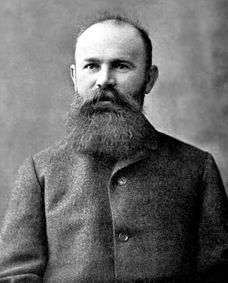Nicolai Ivanovich Andrusov
Nicolai Ivanovich Andrusov (Russian: Николай Иванович Андрусов, Nikolay Ivanovich Andrusov) (December 19, 1861 – April 27, 1924) was a Ukrainian geologist, stratigrapher, and palaeontologist.

He was born in Odessa, then a part of Russia. He studied geology and zoology at the Novorossia University in Odessa. He then traveled across Russia and central Europe to collect fossil specimens.
The Challenger expedition of 1872–1876 studied processes of the sea floor. In 1889 Andrusov published a review of this expedition in Gornyi zhurnal (Mining Journal). He would later perform studies of the geology and sediments of the Ponto-Caspian steppe.[1]
In 1890-91 he participated in a deep water expedition to the Black Sea by the Russian Geographical Society. This expedition discovered hydrogen sulfide in the lower portions of this sea. Andrusov was the first to propose that this substance was created by biological decomposition of life forms (bacteria) containing sulfurous compounds.
He was married to Nadezhda Genrikhovna Schliemann in 1899, the daughter of the somewhat notorious archaeologist Heinrich Schliemann. In 1905 he became a professor at the University of Kiev. In 1914 he became a member of the Russian Academy of Sciences. He emigrated to France in 1920 due to illness. In 1919 he learned about the death of his elder son, and suffered a stroke which resulted in paralysis of a leg and an arm. His relatives decided to move him to Paris, where he had an inheritance from his father-in-law. In 1922 he moved to Prague due to material difficulties, where he died in 1924.
His son Dimitrij Andrusov became a notable geologist and a member of the Slovak Academy of Sciences.
The wrinkle ridge Dorsa Andrusov on the Moon is named after him, as well as the Mid-Black Sea High - Andrusov Ridge.
References
- Bio summary, Web Portal of Ukrainian Government, archived from the original on 3 March 2016, retrieved 1 March 2016
Further reading
- Tikhomirov, V.V. (1970). "Andrusov, Nikolai Ivanovich". Dictionary of Scientific Biography. 1. New York: Charles Scribner's Sons. pp. 161–163. ISBN 0-684-10114-9.